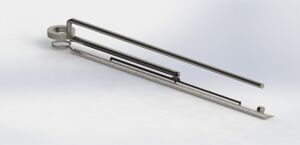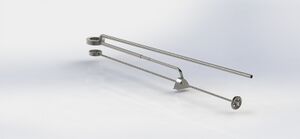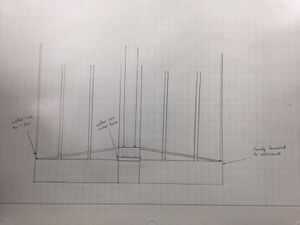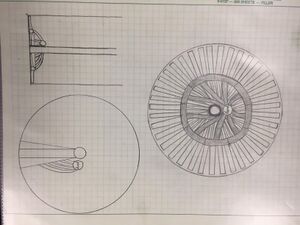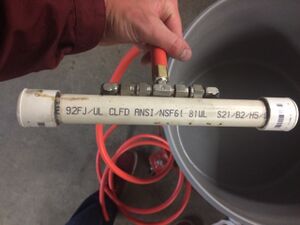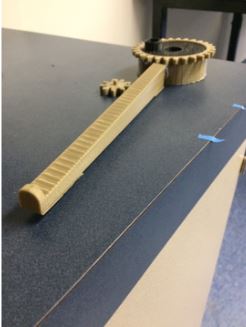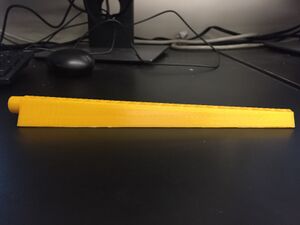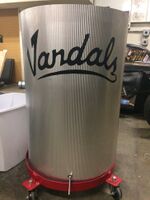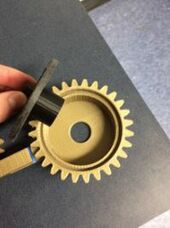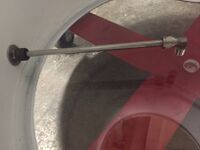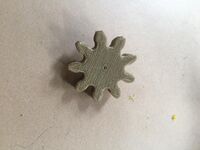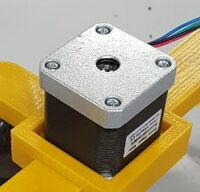Sediment Cleaning of Water Tanks
| Final Design
| |
| Sponsors | |
| Team Name | H2Only |
| Duration | Fall 2016 – Spring 2017 |
| Faculty Advisers | Dr. Tao Xing |
| Client | Scott Smith |
| Team Members |
|
There are three water towers on the University of Idaho campus, three more in the city of Moscow, countless more in the United States, and they all have the same problem; sediment buildup. On campus these water tanks are either used for as potable water for drinking or chilled water for the steam plant.
Problem Statement
The Energy Plant of the University of Idaho is looking for a solution to sediment cleaning for chilled water tank. The current approach is time consuming, expensive, and the chilled water service must be stopped during the cleaning process. The current method requires the tank to be drained of almost 2.5 million gallons and having someone from facilities clean it manually. The other option is to hire scuba divers to go in the tank and remove the sediment with a vacuum. That alone costs around $55,000. Water is wasted when it is removed, and the water needs to be chilled to the correct temperature once the tank is operating again. Any chemicals used to prevent rusting and killing bio-growth is lost during the process and has to be replaced. The total cost of the operation is over $230,000 for the chilled water tank.
Design Specifications
| Description | Current Status | Priority |
|---|---|---|
| Create a semi-transparent tank (no more than 50 gallons) that can validate proof of concept | Complete | Medium |
| Acquire surrogate sediment with comparable density/viscosity | Complete | Medium |
| Scalable to full scale dimensions | Complete | High |
| Avoid re-suspension | Complete | High |
| Create evenly distributed suction through slit | Complete | High |
| Device system for collecting and disposing of sediment | Complete | Medium |
| Create automated sediment level detection | Researching | Low |
| Description | Current Status | Priority |
|---|---|---|
| Bill of materials, drawing, and system diagram that can be implemented by UI facilities staff | In Progress | High |
| Remove 95% of sediment each time system operates | Complete | Medium |
| Continue tank operation while cleaning | Complete | High |
| External sediment separation and recycle of clean water | In Progress | High |
| Easy maintenance | Complete | Medium |
| Fully automated operation | In Progress | Medium |
| Components fit within the existing tank structure and penetrations | Complete | High |
| Versatility for application in multiple tanks | In Progress | Medium |
Alternative Design Selection
| Picture | Device | Pros | Cons |
|---|---|---|---|
| Full Sweeping Suction Device | Complete removal with single armature rotation Minimal moving parts Simple design Inexpensive Low likelihood of complications |
Minimized suction force due to large suction slit Inability to maneuver over and around obstacles Lack of suction control Possibility for clogging throughout system | |
| Vacuum on Lead Screw | Can handle larger sediment buildups Large, localized suction force Potential to be very versatile Not as prone to internal buildup and clogging |
Many mechanical parts Expandable tube Lengthy tank cleaning duration Inability to maneuver above and around obstacles Heavy steel lead-screw | |
| Diaphragm in Tank | More localized suction High flow rates Turbulence would help loosen up sediment It would clean all tank areas |
It would need a large frame to support it Costly to power the raising and lowering of the frame Material would be costly as well | |
| Multiple Tubes | It could reach all the areas of the tank It would remove the sediment the fastest |
Material would be costly for large tanks Costly to create all the suction needed for all the hoses |
Prototypes
| Picture | Description |
|---|---|
| This model was to test the effectiveness of sediment and water removal with the head pressure we had. It was made from round PVC pipe with end caps on it. The bottom of it was machined to create a flat surface for our suction slit to be made. We also used this to find a slit size that would prevent clogging. | |
| Our second prototype was made almost entirely out of 3D printed material. Parts assembled together to test different sweeper arms and to easily make changes to our design if we needed to. The bottom slit was made the same size for all our sweeper arms. |
Sweeper Arm Alternatives
Final Prototype Design
| Components | Description |
|---|---|
| Model Tank: 1:33 scale size model tank. Will be raised four feet to simulate head pressure in actual water tank. | |
| Slip Ring: This allows us to rotate our sweeper arm without having to worry about our exit pipe twisting or needing extendable pipes. It is a two part device with a bottom moving base placed around the support beam, and a stationary cap attached to an exit pipe. It has a 28 tooth gear attached to the moving base to rotate our device, and keep our motor out of the water. | |
| Sweeper: One of our current sweeper designs. This one is easy to manufacture for the full scale size. Separation, turbulence, and re-suspension will not be an issue while it moves at the bottom of the tank. It has a slit at the bottom that creates even suction throughout the length of the sweeper. | |
| Exit Pipe: Exit pipe drilled into the side of the tank to remove our sediment. It is attached to a pump for our prototype. The water and sediment will be removed from the tank and sent into an external separation device. | |
| Axle: A long axle to allow us to rotate our device in our tank both manually and with a motor.
| |
| Drive Gear: A nine tooth gear connected to our axle to slow down our rotation and give us more torque. More like it are attached on the other end of our axle to connect it to our motor and give us a 3 to 1 gear ratio. | |
| Motor Mount: 3D printed motor mount to keep our motor out of the water and in position to automatically run our cleaning device. Additional pieces allows us to use a different size motor. It rests on the support column of the tank.
| |
| Stepper Motor: 400 step stepper motor used to drive our cleaning device. Later upgraded to a geared stepper motor for more torque. The motor sits on the top of the motor mount. |
Team Members
| Photos | Bio |
|---|---|
| Eric Hill:
Major - Mechanical Engineering | |
| James Rockwell:
Major - Mechanical Engineering | |
| Marshall Bolen:
Major - Mechanical Engineering | |
| Lucio Barajas:
Major - Mechanical Engineering |
Document Archive
Meeting Minutes
Fall Semester
Spring Semester
Other Documents
Team Contract
Client Interview
Design Review
DFMEA
Detailed Design Review
EXPO Poster
Technical Presentation
Design Report

